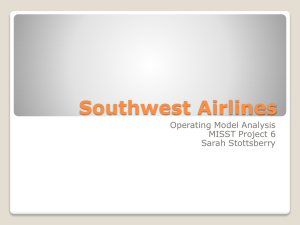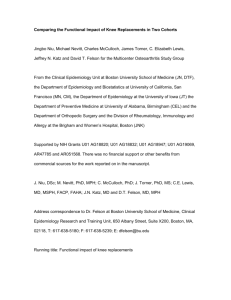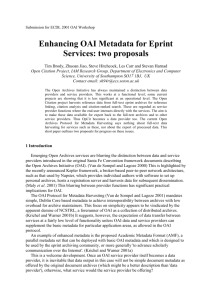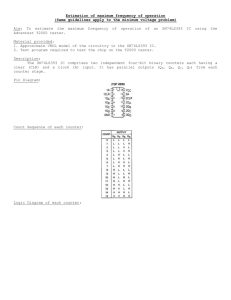dp9_jcdl
advertisement
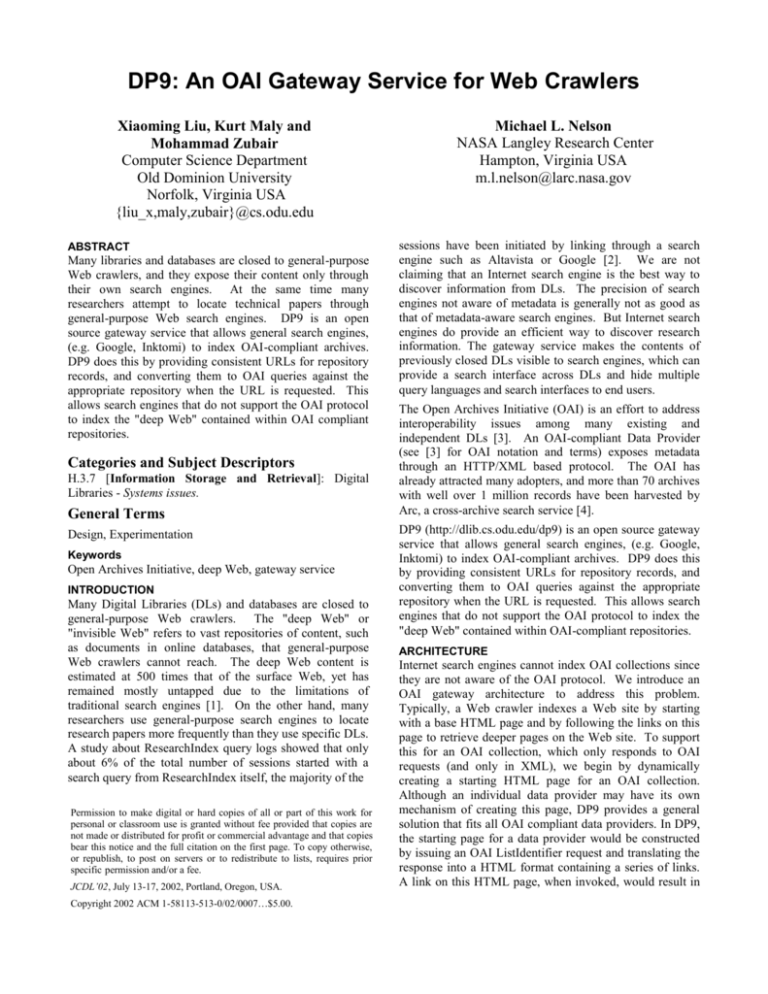
DP9: An OAI Gateway Service for Web Crawlers
Xiaoming Liu, Kurt Maly and
Mohammad Zubair
Computer Science Department
Old Dominion University
Norfolk, Virginia USA
{liu_x,maly,zubair}@cs.odu.edu
ABSTRACT
Many libraries and databases are closed to general-purpose
Web crawlers, and they expose their content only through
their own search engines. At the same time many
researchers attempt to locate technical papers through
general-purpose Web search engines. DP9 is an open
source gateway service that allows general search engines,
(e.g. Google, Inktomi) to index OAI-compliant archives.
DP9 does this by providing consistent URLs for repository
records, and converting them to OAI queries against the
appropriate repository when the URL is requested. This
allows search engines that do not support the OAI protocol
to index the "deep Web" contained within OAI compliant
repositories.
Categories and Subject Descriptors
H.3.7 [Information Storage and Retrieval]: Digital
Libraries - Systems issues.
General Terms
Design, Experimentation
Keywords
Open Archives Initiative, deep Web, gateway service
INTRODUCTION
Many Digital Libraries (DLs) and databases are closed to
general-purpose Web crawlers. The "deep Web" or
"invisible Web" refers to vast repositories of content, such
as documents in online databases, that general-purpose
Web crawlers cannot reach. The deep Web content is
estimated at 500 times that of the surface Web, yet has
remained mostly untapped due to the limitations of
traditional search engines [1]. On the other hand, many
researchers use general-purpose search engines to locate
research papers more frequently than they use specific DLs.
A study about ResearchIndex query logs showed that only
about 6% of the total number of sessions started with a
search query from ResearchIndex itself, the majority of the
Permission to make digital or hard copies of all or part of this work for
personal or classroom use is granted without fee provided that copies are
not made or distributed for profit or commercial advantage and that copies
bear this notice and the full citation on the first page. To copy otherwise,
or republish, to post on servers or to redistribute to lists, requires prior
specific permission and/or a fee.
JCDL’02, July 13-17, 2002, Portland, Oregon, USA.
Copyright 2002 ACM 1-58113-513-0/02/0007…$5.00.
Michael L. Nelson
NASA Langley Research Center
Hampton, Virginia USA
m.l.nelson@larc.nasa.gov
sessions have been initiated by linking through a search
engine such as Altavista or Google [2]. We are not
claiming that an Internet search engine is the best way to
discover information from DLs. The precision of search
engines not aware of metadata is generally not as good as
that of metadata-aware search engines. But Internet search
engines do provide an efficient way to discover research
information. The gateway service makes the contents of
previously closed DLs visible to search engines, which can
provide a search interface across DLs and hide multiple
query languages and search interfaces to end users.
The Open Archives Initiative (OAI) is an effort to address
interoperability issues among many existing and
independent DLs [3]. An OAI-compliant Data Provider
(see [3] for OAI notation and terms) exposes metadata
through an HTTP/XML based protocol. The OAI has
already attracted many adopters, and more than 70 archives
with well over 1 million records have been harvested by
Arc, a cross-archive search service [4].
DP9 (http://dlib.cs.odu.edu/dp9) is an open source gateway
service that allows general search engines, (e.g. Google,
Inktomi) to index OAI-compliant archives. DP9 does this
by providing consistent URLs for repository records, and
converting them to OAI queries against the appropriate
repository when the URL is requested. This allows search
engines that do not support the OAI protocol to index the
"deep Web" contained within OAI-compliant repositories.
ARCHITECTURE
Internet search engines cannot index OAI collections since
they are not aware of the OAI protocol. We introduce an
OAI gateway architecture to address this problem.
Typically, a Web crawler indexes a Web site by starting
with a base HTML page and by following the links on this
page to retrieve deeper pages on the Web site. To support
this for an OAI collection, which only responds to OAI
requests (and only in XML), we begin by dynamically
creating a starting HTML page for an OAI collection.
Although an individual data provider may have its own
mechanism of creating this page, DP9 provides a general
solution that fits all OAI compliant data providers. In DP9,
the starting page for a data provider would be constructed
by issuing an OAI ListIdentifier request and translating the
response into a HTML format containing a series of links.
A link on this HTML page, when invoked, would result in
another OAI GetRecord request for a specific identifier.
Again, the response for such a request would be translated
into an HTML page with appropriate links. In other words,
an HTML page presented to a Web crawler is a result of an
OAI request, and the links on the Web page lead to other
OAI requests. DP9 supports the resumption token and
HTTP 503 status code “retry-after” and thus provides a
basic flow control for large data providers. Note that the
flexibility in the OAI protocol allows different ways of
constructing the HTML pages to expose an OAI collection.
For example, the starting page could have been constructed
using the OAI request ListRecords. The sequence of OAI
requests we have used in our design was driven by what
would be useful for crawlers.
DP9 uses links on Web pages that have the following
format:
http://{hostname}/dp9/getrecord/{MetadataFormat}/{OAI_
ID}. An example is:
http://arc.cs.odu.edu:8080/dp9/getrecord/oai_dc/oai:NACA
:1917:naca-report-10
DP9 creates a series of ListIdentifiers pages for each
archive with links to all individual records. These URLs
are static and will be only activated when a HTTP request
is received. DP9 provides an entry page and if a Web
crawler finds this entry page, it may follow the links on this
page and send requests to DP9. DP9 will then forward the
request to corresponding OAI data providers and process
the returned XML records. Depending on the depth a
crawler follows, it can index all records in an OAI data
provider.
DP9 consists of three main components (Figure 1), an URL
wrapper, an OAI handler and an XSLT processor. The
URL wrapper accepts the persistent URL and calls internal
JSP/Servlet applications. The OAI handler issues OAI
requests on behalf of a Web crawler. The XSLT processor
transforms the XML content returned by the OAI archive to
an HTML format suitable for a Web crawler. XSLT allows
DP9 to support any XML metadata format simply by
adding an XSL file. DP9 is based on Tomcat/Xalan/Xtag
technology from Apache.
RESULTS AND FUTURE WORK
We have collected 70 OAI repositories with well over one
million records. Considering Parallel Metadata Sets [3] are
supported by OAI leading to more references, potentially
several millions of pages could be indexed by Web search
engines. With DP9 now being deployed, thousands of
documents in OAI collections have been indexed by search
engine such as Inktomi and Google. Web logs show that
more than 1000 queries are issued from popular Web
search engines each day.
DP9 is a gateway service, it does not cache the OAI records
and only forwards requests to corresponding OAI data
providers. This insures DP9’s records are always up-todate; however, its quality of service is highly dependent on
the availability of OAI data providers. On the other hand,
an aggressive crawler using DP9 can rapidly send requests
without regard for the load they are placing on the data
providers. The robot exclusion protocol [5] at the data
provider site will not be observed because the requests
come from DP9, an OAI service provider. We are studying
the possibility of using an OAI mirror/caching mechanism
such as OAI Aggregator [6] and HTTP throttle software to
relieve the overhead on data providers.
DP9 also provides an easy way to build services for OAIcompliant repositories. Indexing tools such as htdig and
GreenStone are designed to index websites, they could be
used to build searching services for OAI collections with
DP9 support.
ACKNOWLEDGEMENTS
We thank Rick Luce, Tim Brody, Herbert Van de Sompel,
Andy Powell, Thorsten Schwander, Larry Stone, Walter
Underwood, for valuable feedback and recommendations.
This work was supported by the ODU DL group and the
LANL Research Library.
REFERENCES
1.
M. K. Bergman. The Deep Web: Surfacing Hidden
Value. Journal of Electronic Publishing, 7(1), 2001.
2.
M. Mahoui and S. J. Cunningham. Search Behavior in
a Research-Oriented Digital Library. Proceedings of
ECDL2001, Darmstadt, Germany, September 4-9,
2001, LNCS 2163, pp. 13-24.
3.
C. Lagoze and H. Van de Sompel. The Open Archives
Initiative: Building a low-barrier interoperability
framework. Proceedings of the ACM/IEEE Joint
Conference on Digital Libraries, Roanoke VA, June
24-28, 2001, pp. 54-62.
4.
X. Liu, K. Maly, M. Zubair, and M. L. Nelson. Arc An OAI Service Provider for Digital Library
Federation, D-Lib Magazine 7(4), April 2001.
5.
M. Koster. The Web Robots Page. Available at
http://info.webcrawler.com/mak/projects/robots/robots.
html
6.
OAI Perl. Available at http://oai-perl.sourceforge.net/
Figure 1. DP9 Architecture
Some crawlers use the HTML meta tags to index a Web
pages; so in addition to creating the user friendly HTML
page, DP9 also maps Dublin Core metadata to
corresponding HTML meta tags. For pages that are
designed exclusively for robots navigation, a noindex
robots meta tag is used.
